Nahensteig 189 „schwarzer Hahn“
Renovation of a Landshut Landmark, with a “historic” gastronomy
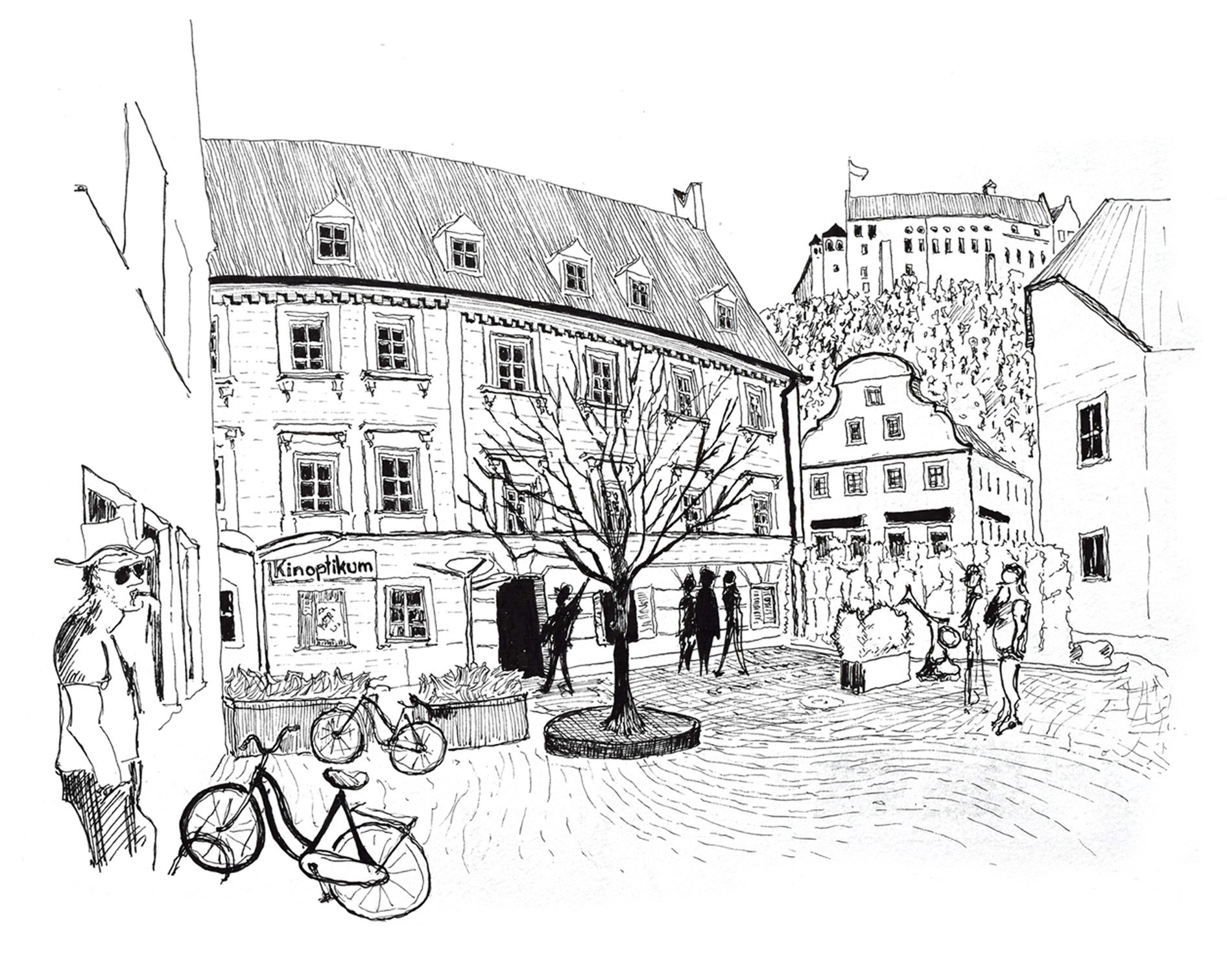
The history of the property is described in length in Theo Herzog’s house chronicle from 1493. It is believed to have been operating as an inn from as early as 1812, when the brewer Michael Strasser purchased it. In 1904, under the leadership of the brewery owners Fritz and Eugen Fleischmann, the inn was given the name “Schwarzer Hahn”. It began as a middle-class workers’ pub which also housed a fully operational kitchen, which was located in what now serves as the back dining area.
History of the house
Client/Planning: F. Fichtel
Location: Landshut
Status: completed 2021
Service phases: 1-9
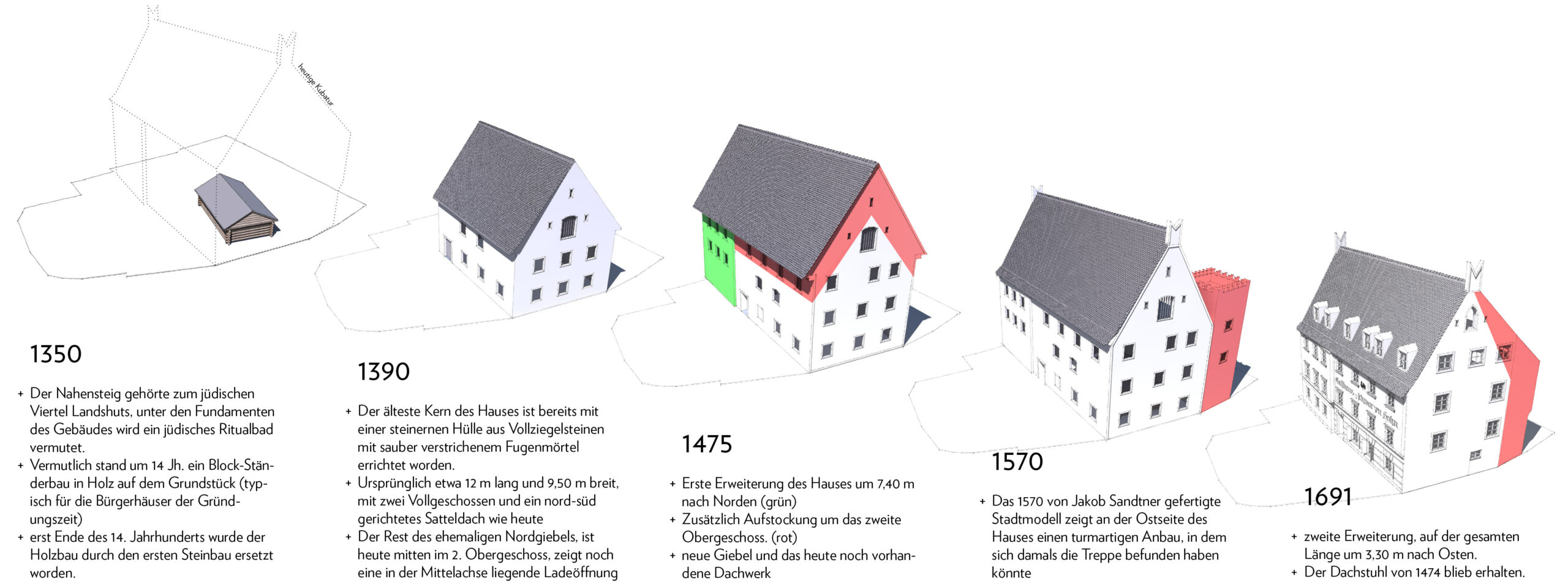
Basic concept for restoration
The primary goal in preserving the structure was to restore the structural integrity of the structure, as well as preserve as many of the original materials as possible. Elements that were not part of the original character or structure were removed for conservation purposes, dating back as far as the early 19th century. The necessary restoration and refurbishment also offered the opportunity to enhance the appearance of the building both aesthetically, as well as to optimize its functionality – always based on the verifiable original historical circumstances. Contemporary upgrades should help to secure the future of this landmark building and its “listed gastronomy”.
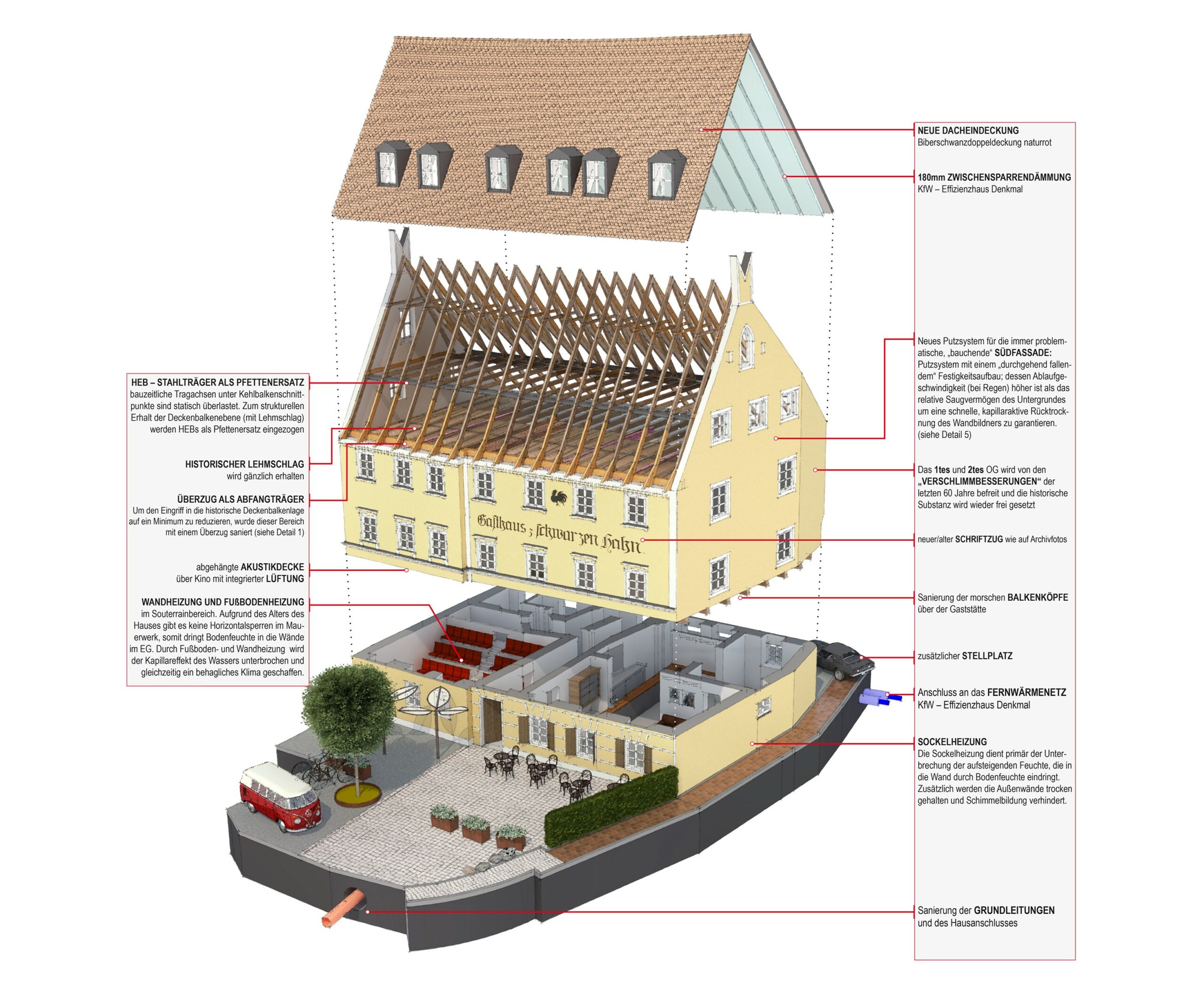
Important and essential details
-
Roof/top floor joist layer:
Unfortunately, almost all of the ceiling beams at the foot of the inner courtyard (axis A/beer garden side) were destroyed. A rehabilitation of these points would have resulted in the complete dismantling of the planks and the historic clay fill. As a result, this area was renovated with a cover: the individual ceiling beams hung on the roof with threaded rods, in order to allow the remaining load from the rafters to be transferred to the cover via the screw connection and bearing blocks. The intervention in the historical ceiling beam position was kept to a minimum, only the mold-infested areas of the existing beams were trimmed back.
(detail 01)
Simultaneously, the new roof also serves as a support point for the (partially damaged) rafters; with such a steep roof pitch, the beam and rafter heads would always be susceptible to water penetrating. Indenting the support point is also the right solution in terms of sustainability.
To support the new coating, three steel girders were installed in the ceiling level. Together with the two gable walls and a load-bearing middle wall, they form the six support and load-bearing points for the new girder (detail 04). The girders were installed flush with the ceiling, parallel to the ceiling beams. The plank in between was split in the middle and then stored in the flanges of the steel girders (detail 02)
The collar beams are connected to the rafters with a dovetail blade. The timber cross-sections, which were tapered for this exact purpose, showed deformations and damage due to the relocation to the middle purlin at an early stage of the conversion. The load transfer of the upper truss triangle was no longer guaranteed. For this reason, we rehabilitated the junction with a continuous sloping purlin, in which the rafters and collar beams were anchored with full-thread screws. A statically verifiable connection is thus possible without lashing the partially visible dovetail joints. (detail 03)
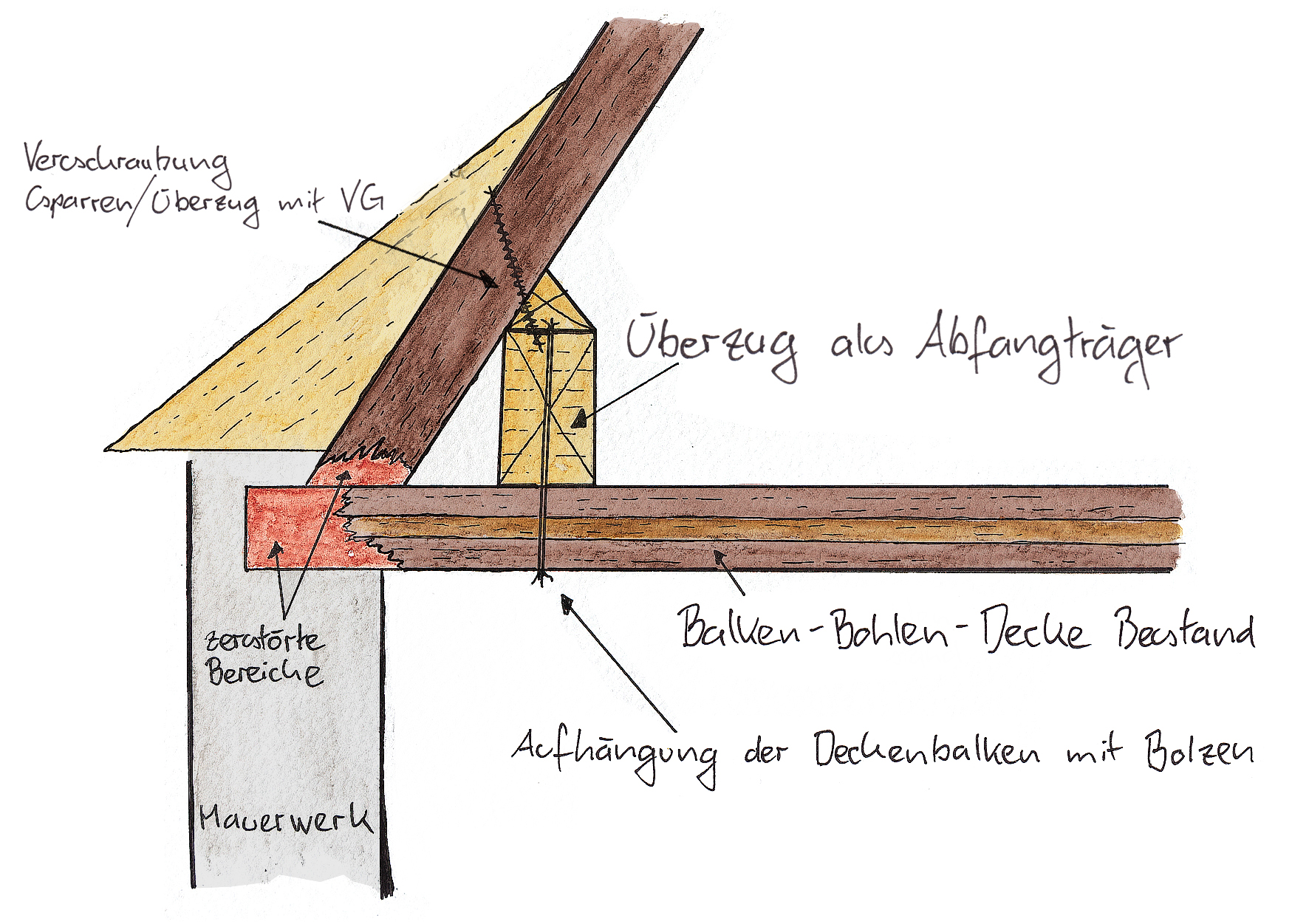
Detail 1
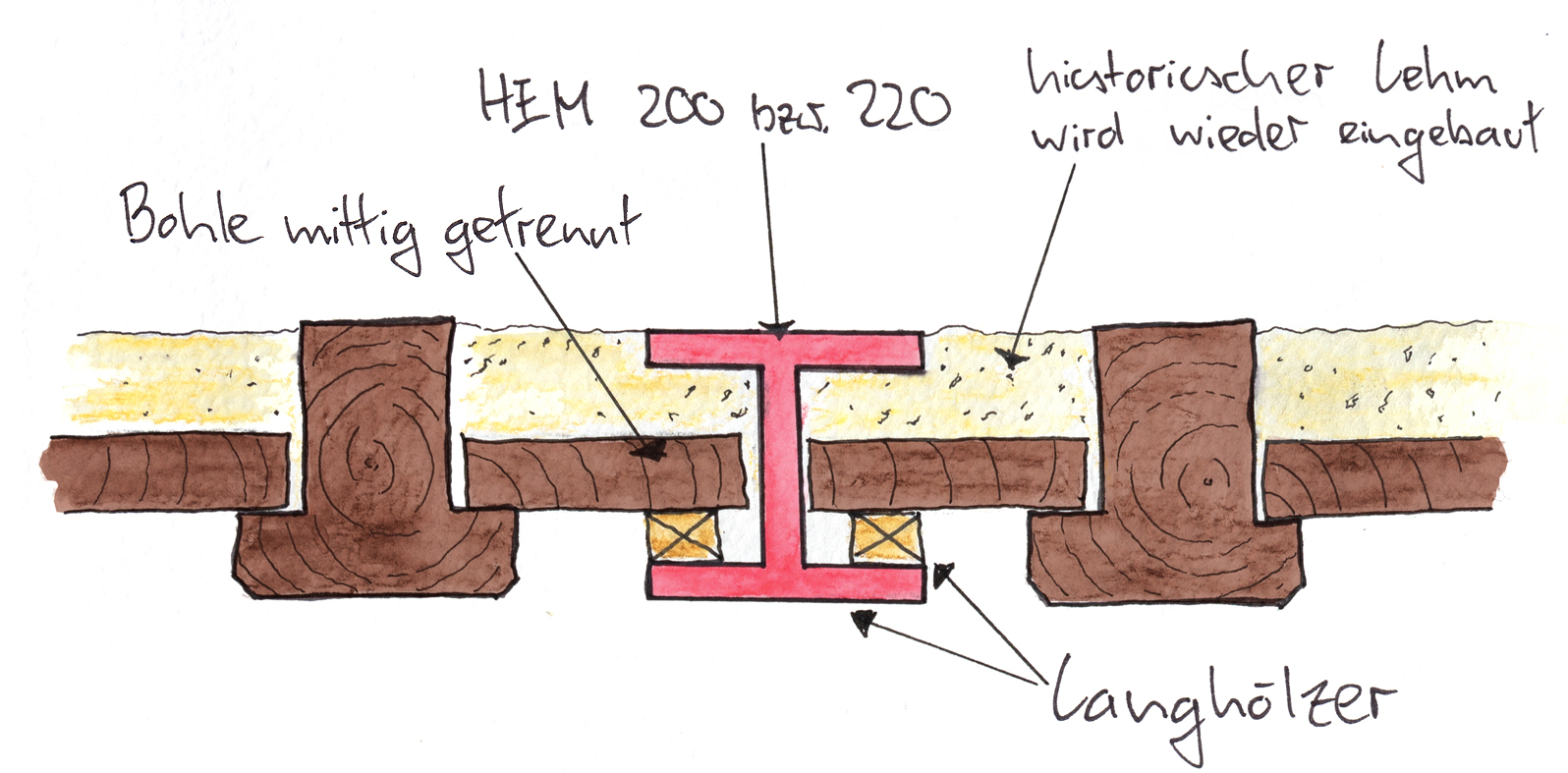
Detail 2
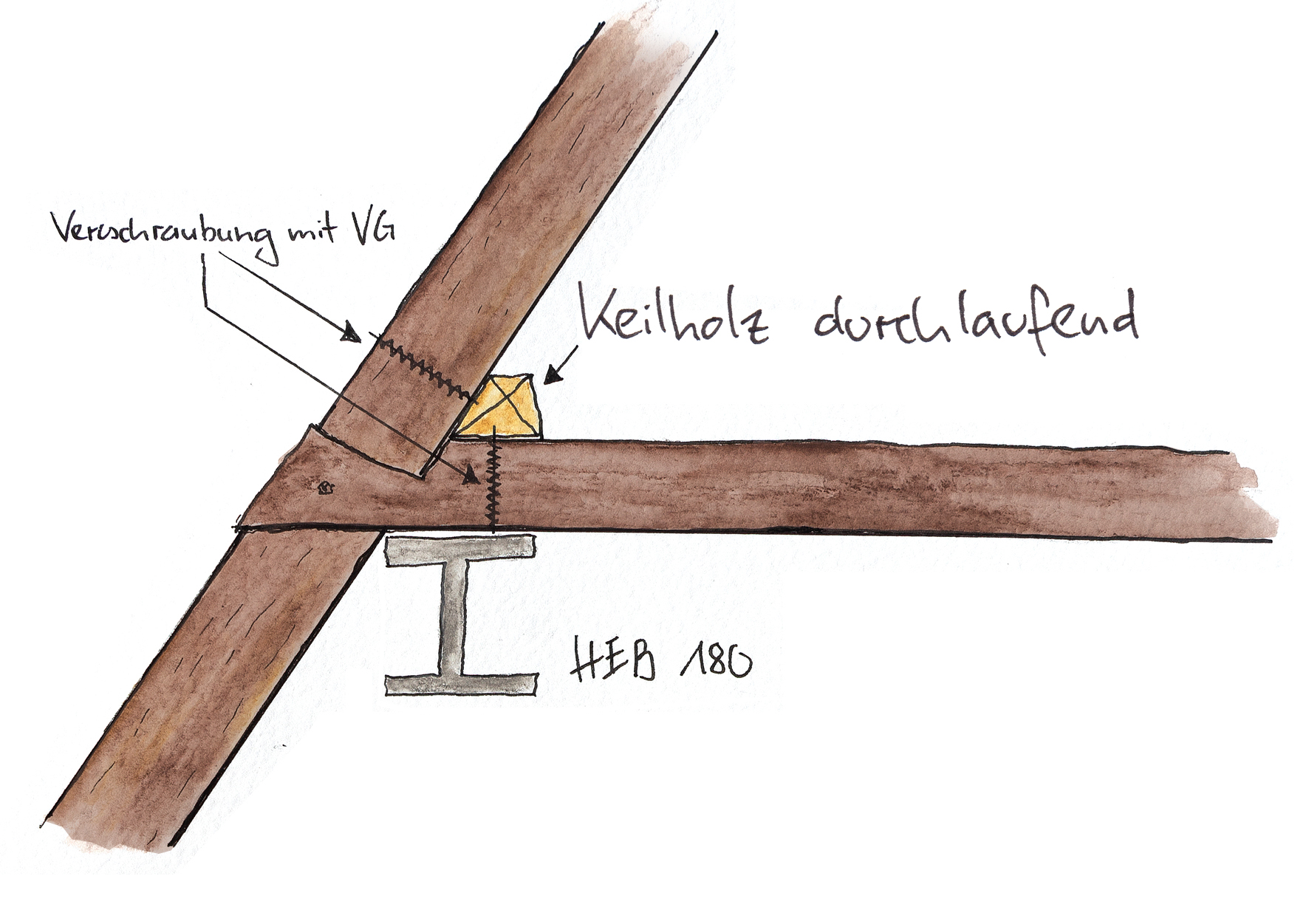
Detail 3
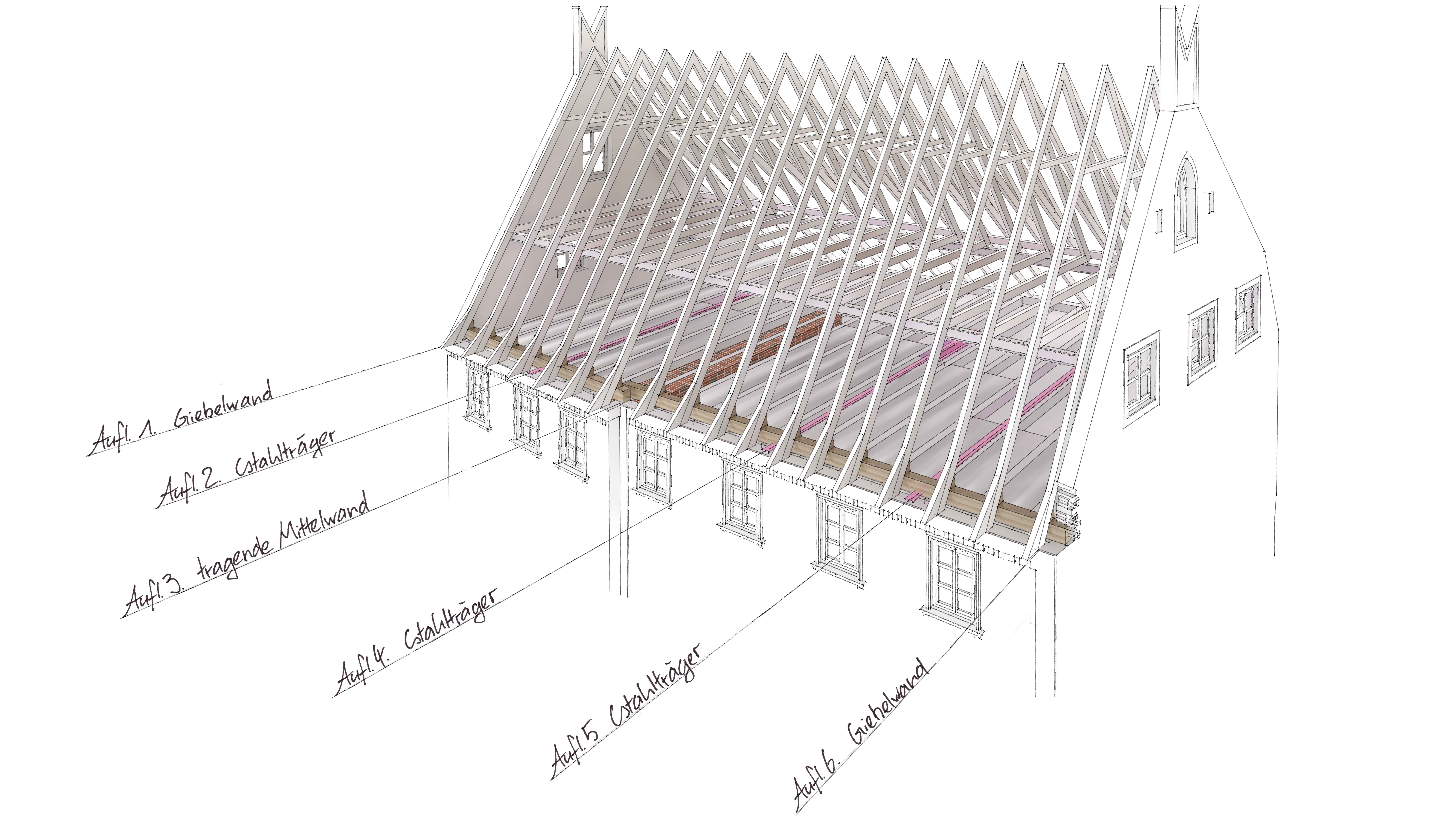
Detail 4
-
South facade
Only purely mineral mortar and plaster systems (predominantly lime-based) without any hydrophobic components and a weak hydrophilic base finish were utilized. The use of cement-based mortars was ruled out, since highly hydraulic, cement-based plaster mortars with water-repellent additives, due to their own product hardness and later crack formation, are prone to “evasion” with regard to the historical building structure.
Due to the “bulky” south facade, water penetrating the outer wall is a major problem, the best example being the rotten beam heads in the ceiling beam position on the 1st floor (here all beam heads were rotten). A long-term solution was difficult, because e.g. a renovation plaster would be oversaturated after five years at best (hence its naming “sacrificial plaster”).
In order to avoid water ingress in the future, a denser plaster could have been used. However, since such a (dense) plaster mortar does not have any crack-bridging properties, we would need the substrate to be permanently free of cracks, which experience has shown to be impossible in a historical building.
Ultimately, we decided on a system that has a “continuously falling” strength structure (soft to firm) in its structure on the outside and with its “falling grading curve” has an increased water drainage speed (decreasing surface roughness) – with permanent capillary activity at the same time! So you can see that “tightness” is not a desirable or even necessary goal in the facade area. It is sufficient if the “run-off speed” is higher than the “relative suction capacity of the substrate” and is permanently guaranteed!
By observing these structural principals, there is always rapid, capillary-active redrying of the wall former, even if cracks form later. (detail 05)
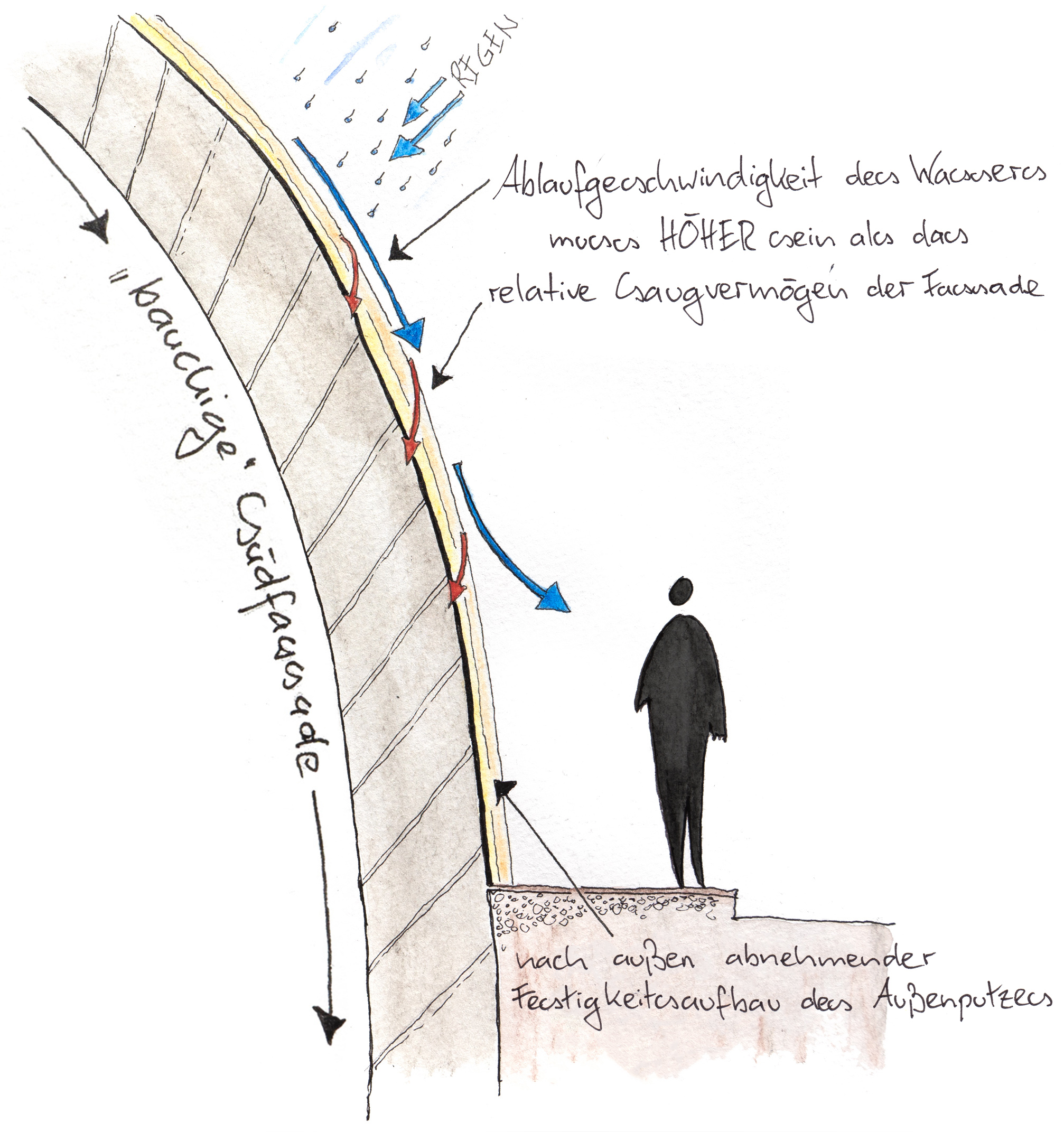
Detail 5
-
Wall heating/special plaster in the restaurant
The difficulty in selecting the interior plaster was to find an insulating plaster that could be applied despite the moisture and salts in the subsoil. A capillary-active cleaning system (condensate absorption) should be built up with a permanently non-capillary-active proportion of air pores.
A special insulating plaster was selected with processed cork. This composition causes a good insulation value, good moisture buffer and transport properties and increased resistance to crystallization pressures that occur. Since the cork-based insulating plaster is formulated specifically for the highest possible reduction in the heat transfer value, while at the same time having good buffering properties against salts in the plaster base, it strengthens the effect of the wall heating and also serves the well-being of the guests. Besides, what plaster would have fitted better into the black faucet than plaster into which old wine corks were worked?
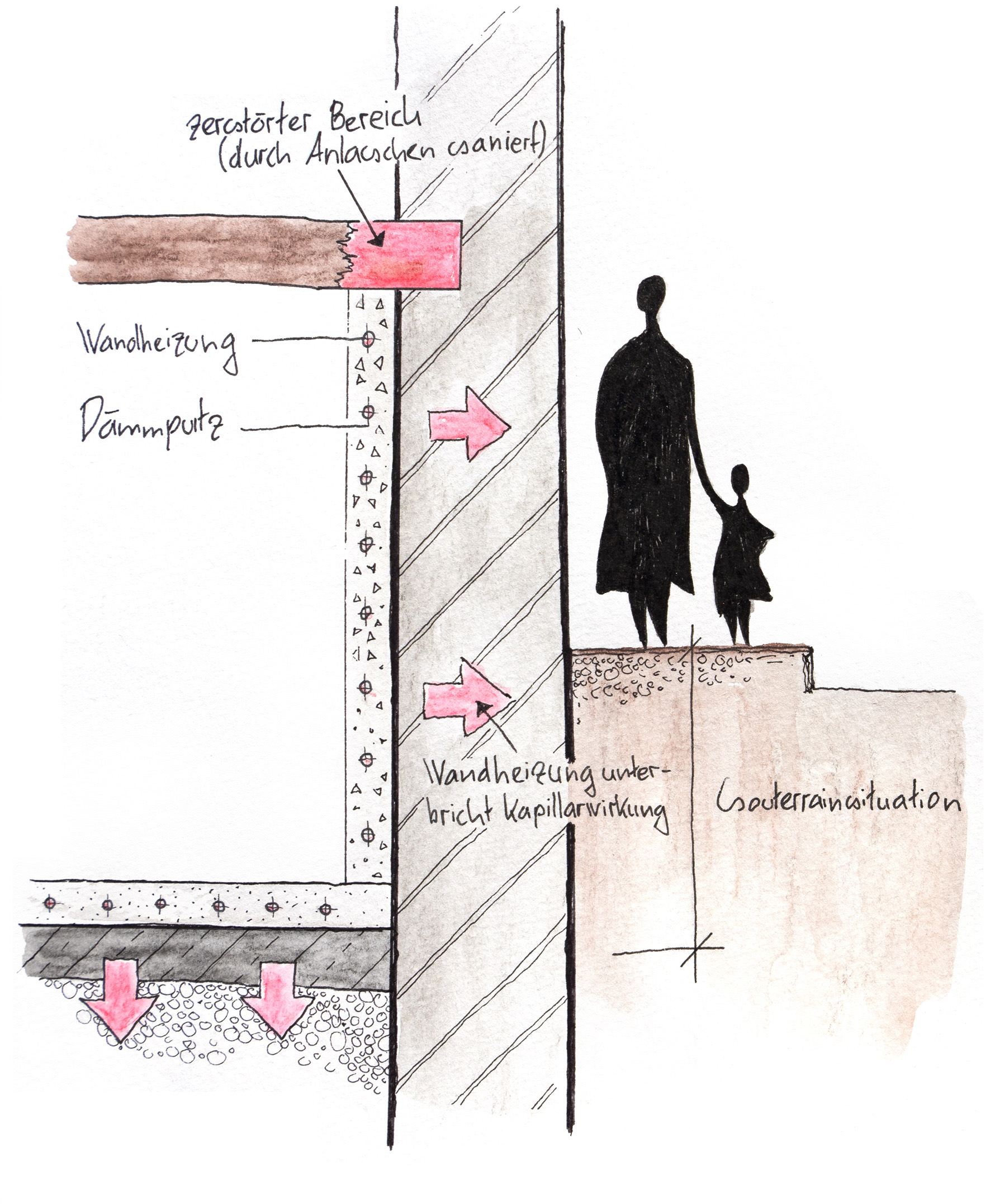
Detail 6
-
Wood-concrete composite floor above the restaurant
The ceiling beams above the restaurant are partially composed of reused wood, some have grooves for clay wraps or planks. In between or adjacent heated beams, however, not. This mixture of components shows that these are second-use beams. In addition, we found stencil paintings in synthetic blue between the wooden beams, so the relocation of the beams in the restaurant area can only have taken place at the beginning of the 20th century.
Maintaining the character of the house as a “restaurant with living space above” presented a major planning challenge. Having the restaurant and cinema on the ground floor were systematically a part of the house. Conversely, the components for a contemporary living space are quite high and complex.
The ceiling above the restaurant was designed as a wood-concrete composite ceiling (detail 07): This gave us a higher load-bearing capacity, optimal soundproofing and improved fire protection. Especially the latter is an important point in the monument!
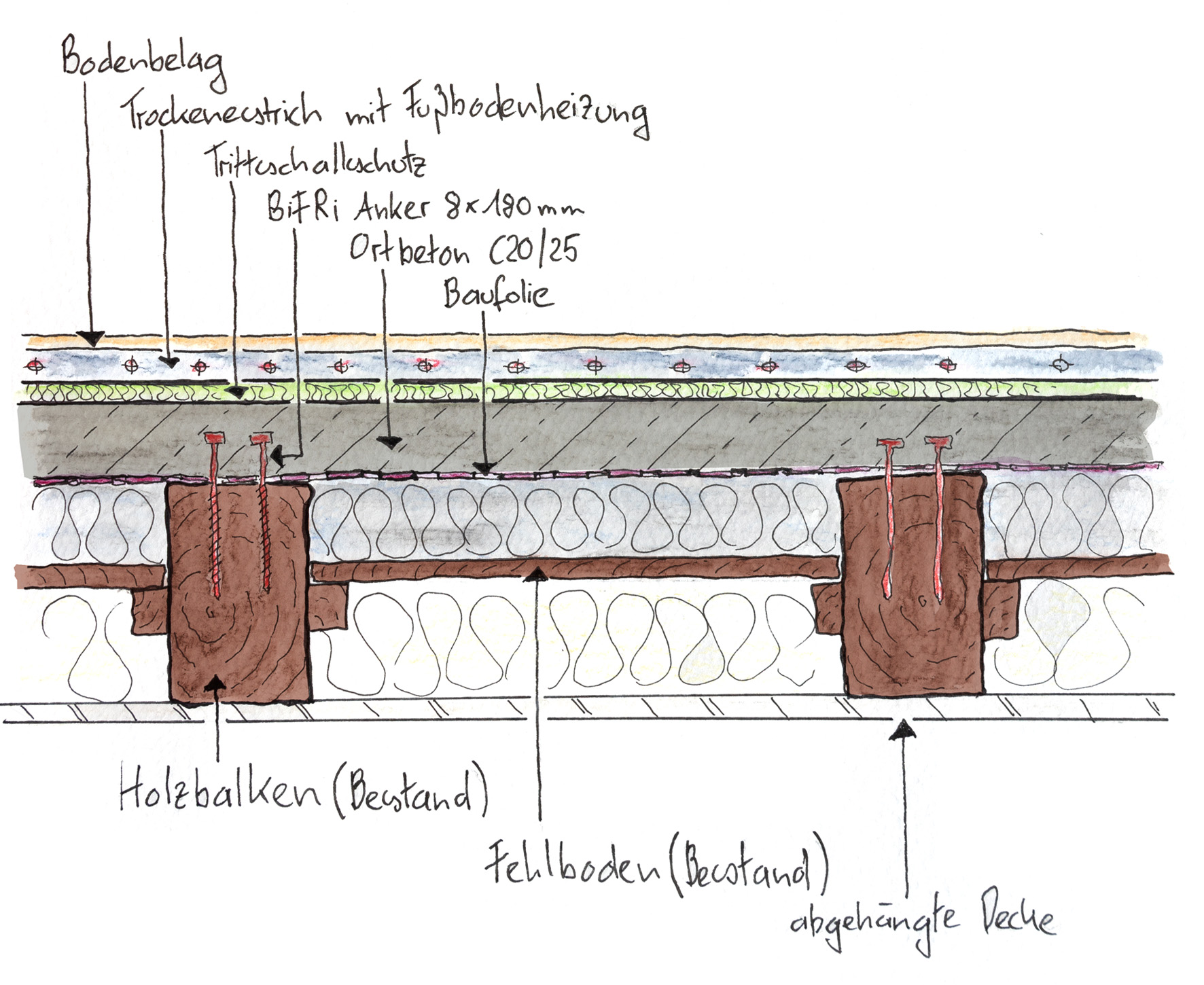
Detail 7
The transformation
Photo credit: Peter Litvai Altstadt 195A, 84028 Landshut
The following photos impressively show what was only possible through the cross- disciplinary cooperation of many colleagues and a great deal of attention to detail.

left: The “Hösl” family in front of the Gasthaus zum Schwarzen Hahn (around 1905)
right: The Schwarzer Hahn in a “new dress” and with the old lettering. The new/old lettering was hand-drawn by Josip Jurakic from the old photo (left).

left: Behind a modern, suspended ceiling, a heavily damaged Rieblinksceiling (1475) with dark bister glaze was revealed. The underside of the beams have been “shaved off” and have only been “renovated” in a makeshift manner using auxiliary structures.
right: Reinforced with an I-beam (not visible), the historic beam-and-bolt ceiling from 1475 appears in its former glory. The wall lamps were modified specifically for this project so that they highlight the lovingly renovated, historical substance without drawing attention to themselves.

left: Dismantled half-timbered wall of the second house extension from 1691 with wedge timbers already installed and thus leveled Riemlingceiling.
right: Lovingly reconstructed half-timbered wall with exposed brickwork. Due to the visible repair with the wedge wood, the crooked shape of the ceiling before the renovation can still be seen.

left: Historical Riemlingceiling with joists (1474), in pink one of the new support axes for covering the rafter support points on the beer garden side. In the background is the half-timbered wall, the second house extension from 1691.
right: The area of the beam that had been decomposed by excrement was replaced, the half-timbered wall was reconstructed and the ceiling was leveled using wedge timbers. Due to the visible repair with the wedge wood, the crooked shape of the ceiling before the renovation can still be seen.

left: “Light at the end of the tunnel”: Most of the roof structure from 1474, which was built with the first expansion of the house to the north, is still largely there. During the course of the renovation, the roof structure was freed from makeshift auxiliary structures (already done in this photo)
right: As much of the old structure and the roof structure from 1474 was preserved as possible. Only the rotten or rotted rafter and beam sections were renovated using the best carpentry skills with the same profile and standing leaves. The wall lamps modified for this project highlight the lovingly renovated, historical substance without drawing attention to themselves.

left: “Light at the end of the tunnel”: Most of the roof structure from 1474, which was built with the first expansion of the house to the north, is still largely there. During the course of the renovation, the roof structure was freed from makeshift auxiliary structures (already done in this photo)
right: As much of the old structure and the roof structure from 1474 was preserved as possible. Only the rotten or rotted rafter and beam sections were renovated using the best carpentry skills with the same profile and standing leaves.

left: Former gable wall now in the middle of the 2nd floor of the building, a bricked-up loading opening in the middle. The addition of the 2nd floor with the expansion of the house to the north (1474) is clearly visible. The Riemlingceiling with traces of the former room layout made of plank walls dates from the same period.
right: The former loading opening was designed as a niche and is reminiscent of earlier times. The wedges used to level the ceiling served as a tool for visible repairs and show the crooked shape of the ceiling before the renovation.

left: After removing the plaster, which was questionable in terms of conservation, this “brick Tetris” was found: a wall consisting of different brick formats from 5 centuries. Above this is the exposed Riemlingceiling (1474) and on the left is the dismantled half-timbered wall before the renovation.
right: Lovingly reconstructed half-timbered wall with exposed brickwork. Due to the visible repair with the wedge wood, the crooked shape of the ceiling before the renovation can still be seen. The wall lamps modified for this project highlight the lovingly renovated, historical substance without drawing attention to themselves.

left: Former northern community wall with boundary stone. Area of the first house extension to the north (1474) with beams and Riemlingsceiling from this period. Some former openings in the north facade were bricked up from 1691.
right: Lovingly reconstructed Riemlingceiling shines in its old splendor. The wall lamps modified for this project not only illuminate the room, but also the lovingly renovated, historical substance without drawing attention to themselves.
